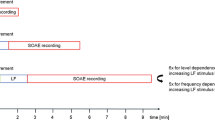Summary
The effects of noise were studied in 90 5-week-old albino Hartley guinea pigs with normal hearing. The following experimental setup was used: (1) exposure to 1 kHz tones at 100 dB for 4 h, 20 h and 40 h; (2) exposure to 1 kHz tones at 110 dB for 20 h and 40 h. In order to investigate the effects of the noise exposures on the hearing of the guinea pigs, cochlear microphonics (CM), whole nerve action potentials (AP) and endocochlear potentials (EP) were examined. We obtained the following results. With a high sound pressure, a decrease was observed in the CM maximum output voltage in the test frequencies from 2 kHz to 6 kHz while the CM threshold increased (“pseudo threshold”). Intensity function of the N1 potential of the AP using a 7 kHz tone burst decreased; the threshold of the N1 potential also increased considerably by exposure to chronic high sound pressure. An extension of latency and a decrease in the absolute value of the negative potential in EP were induced by chronic noise exposure.
Similar content being viewed by others
References
Axelsson A, Vertes D (1982) Histological findings in cochlear vessels after noise. In: Hamernik RP (eds) New perspectives on noise induced hearing loss. Raven Press, New York, p 49
Bohne BA, Zahn SJ, Bozzay DG (1985) Damage to the cochlea following interrupted exposure to low frequency noise. Ann Otol Rhinol Laryngol 94:122–128
Bohne BA, Yohman L, Gruner MH (1987) Cochlear damage following interrupted exposure to high-frequency noise. Hear Res 29:251–264
Bosher SK (1979) The nature of the negative endocochlear potential produced by anoxia and ethacrynic acid in rat and guinea pigs. J Physiol 293:329–345
Davis H (1968) Mechanism of the inner ear. Ann Otol Rhinol Laryngol 77:644–655
Fujii M (1970) The experimental study of acoustic trauma on peripheral hearing organ. Pract Otol 63:557–608
Kryter KD (1985) Noise-induced hearing loss and its prediction. In: Kryter KD (ed) The effect of noise on man, 2nd edn. Academic Press, New York, p 220
Legouix JP, Persan A (1974) Investigation of the source of whole-nerve action potential. J Acoust Soc Am 56:1222–1225
Morita K (1970) Experimental study of endocochlear potential induced by several load conditions. Jpn J Otol 73: 1421–1453
Tasaki I, Spyropulos CS (1959) Stria vascularis as a source of endocochlear potential. J Neurophysiol 22:149–155
Tasaki I, Davis H, Legouix JP (1952) The space time pattern of the cochlear microphonics (guinea pigs), as recorded by differential electrodes. J Acoust Soc Am 24:502–519
Wada J, Kambayashi J, Marcus DC, Thalmann R (1979) Vascular perfusion of the cochlea: effect of potassium free and rubidium substituted media. Arch Otorhinolaryngol 225:79–81
Yamamoto T, Takagi K, Shoji H, Yoneda H (1970) Critical band with respect to temporary threshold shift. J Acoust Soc Am 48:978–987
Yamamura K, Yamamoto N, Sawada Y, Ohno H, Saitoh Y (1988) Effect of high frequency noise on hearing — action potential and endocochlear potentials of guinea pigs. J Sound Vib 127:529–534
Yamamura K, Yamamoto N, Kohyama A, Sawada Y, Ohno H, Saitoh Y (1989) Effect of intense sound exposure on cochlear microphonics and whole nerve action potential. J Sound Vib 131:287–294
Yamamura K, Terayama K, Yamamoto N, Kohyama A, Kishi R (1989) Effect of acute lead acetate exposure on adult guinea pigs: electrophysiological study of the inner ear. Fundam Appl Toxicol 13:509–515
Yoshida M, Abe N, Shida H, Ohyama S, Shida T (1987) Hearing activity of 4 kHz and type of noise induced hearing loss. Audiol Jpn 30:363–364
Author information
Authors and Affiliations
Rights and permissions
About this article
Cite this article
Yamamura, K., Saitoh, S., Fujita, T. et al. Electrophysiological determinations of the effects of 1 kHz noise exposure on the high-frequency hearing of guinea pigs. Eur Arch Otorhinolaryngol 247, 206–210 (1990). https://doi.org/10.1007/BF00178985
Received:
Accepted:
Issue Date:
DOI: https://doi.org/10.1007/BF00178985




